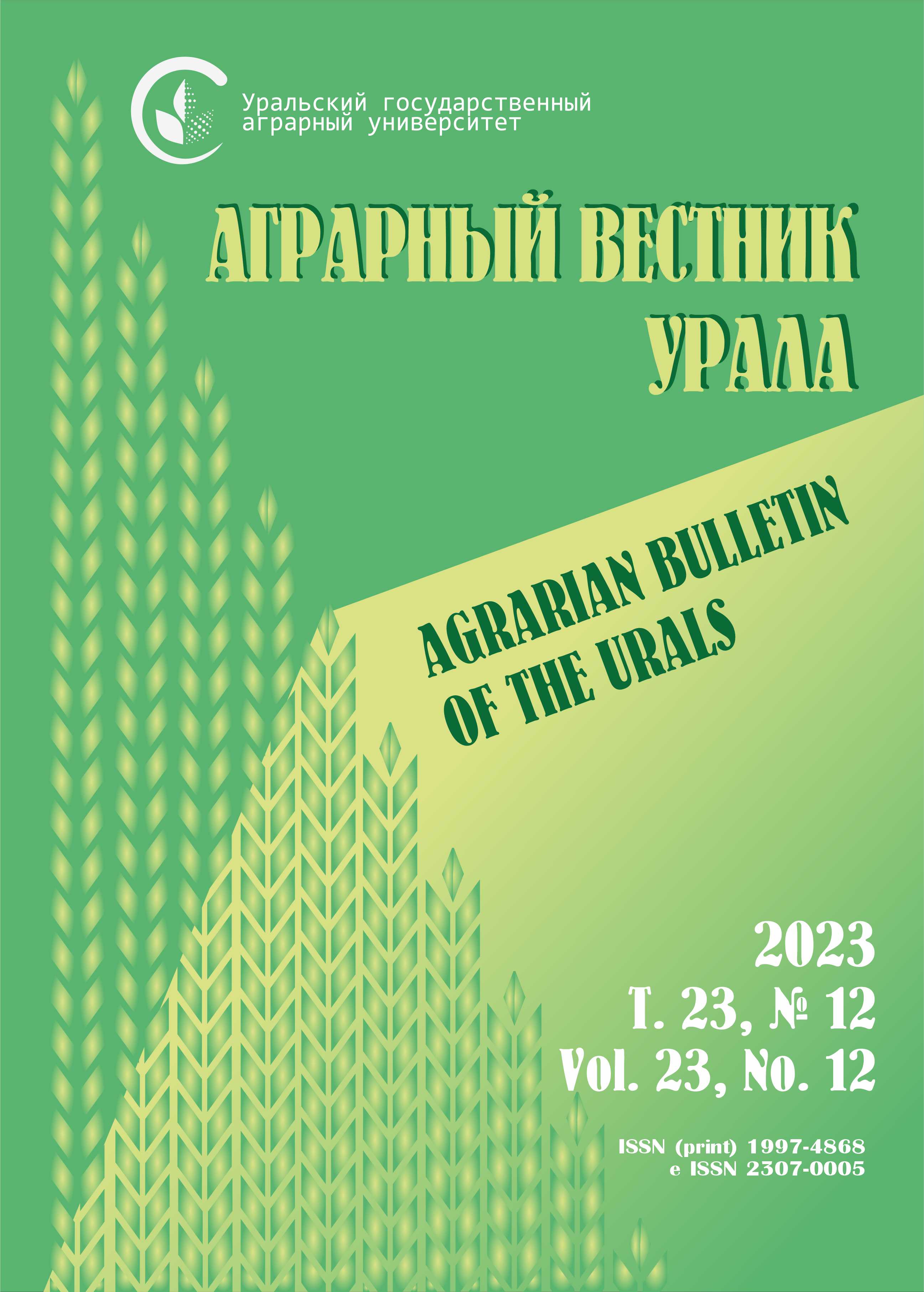Chelyabinsk, Chelyabinsk, Russian Federation
Abstract. The yeast Saccharomyces cerevisiae is widely used in many fermentative processes of food production. At the same time, the spent yeast biomass obtained after production processes generates significant amounts of waste. Thus, in the brewing industry residual brewer's yeast is the second largest volume of waste, which is about 3% of the volume of brewed beer. Utilization of these wastes is rather complicated and requires additional costs from the enterprises. Under these conditions, the directions of additional utilization of spent yeast mass are of high interest. One of such directions can be the use of plasmolysis of spent yeast and its further use for encapsulation of biologically active substances. Among biologically active compounds, plant polyphenols – substances with pronounced antioxidant properties – occupy an important place. Scientific novelty. This study examines dihydroquercetin, rutin and curcumin in their original and nanostructured forms. For these compounds an extensive list of pharmacological properties such as anti-inflammatory, antioxidant, capillaroprotective and others has been established. At the same time, these compounds are characterized by a low level of bioavailability. The purpose of the study was to investigate the possibility of using spent, plasmolysed cells of brewer's yeast Saccharomyces to encapsulate plant polyphenols: dihydroquercetin, rutin and curcumin, and to evaluate the effect of such an approach on the bioavailability of biologically active substances in an in vitro digestion model. Results. As a result of these studies, it was found that plasmolysed yeast cells are able to act as a “delivery system” of plant antioxidants. Using the proposed approaches, it is possible to achieve an encapsulation efficiency of approximately 57–64 %, provided that the polyphenols are ultrasonically nanostructured beforehand. Analysis of the potential bioavailability of encapsulated forms of plant antioxidants in an in vitro gastric digestion model showed that the technology of encapsulation into yeast cells allowed to ensure the preservation of plant antioxidants about 80 %. In comparison with the initial forms of biologically active substances, encapsulation allowed to provide an increase in bioavailability by about 30–40 %.
plasmolysed yeast, encapsulation, plant actioxidants, nanostructuring, bioavailability
1. Gonçalves G. da C., Nakamura P. K., Furtado D. F., Veit M. T. Utilization of brewery residues to produces granular activated carbon and bio-oil // Journal of Cleaner Production. 2017. Vol. 168. Pp. 908-916. DOI:https://doi.org/10.1016/j.jclepro.2017.09.089.
2. Schlabitz C., Lehn D. N., Volken de Souza C. F. A review of Saccharomyces cerevisiae and the applications of its byproducts in dairy cattle feed: Trends in the use of residual brewer's yeast // Journal of Cleaner Production. 2022. Vol. 332. Article number 130059. DOI:https://doi.org/10.1016/j.jclepro.2021.130059. EDN: https://elibrary.ru/OJVPUR
3. Islammagomedova E. A., Halilova E. A., Abakarova A. A. Nekotorye biohimicheskie i morfologicheskie svoystva drozhzhey Saccharomyces cerevisiae v usloviyah stressa (obzor) // Izvestiya vysshih uchebnyh zavedeniy. Severo-Kavkazskiy region. Seriya: Estestvennye nauki. 2022. № 3 (215). S. 129-138. DOI:https://doi.org/10.18522/1026-2237-2022-3-129-138. EDN: https://elibrary.ru/MPPORN
4. Pavlichenko A. I. Vliyanie pischevyh proizvodstv na ekologicheskuyu obstanovku // Aktual'nye problemy formirovaniya zdorovogo obraza zhizni studencheskoy molodezhi: sbornik trudov HIII mezhdunarodnoy mezhvuzovskoy nauchno-prakticheskoy konferencii studentov. Smolensk, 2022. S. 262-265. EDN: https://elibrary.ru/QTEHQL
5. Coradello G., Tirelli N. Yeast cells in microencapsulation. General features and controlling factors of the encapsulation process // Molecules. 2021. No. 26 (11). Article number 3123. DOI:https://doi.org/10.3390/molecules26113123. EDN: https://elibrary.ru/FIGFBK
6. Ying Li, Hang Su, Wenjun Wang, Zhongping Yin, Jing’en Li, En Yuan, Qingfeng Zhang. Fabrication of taxifolin loaded zein-caseinate nanoparticles and its bioavailability in rat // Food Science and Human Wellness. 2023. Vol. 12. Iss. 6. Pp. 2306-2313. DOI:https://doi.org/10.1016/j.fshw.2023.03.034. EDN: https://elibrary.ru/DTUWSX
7. Nilova L. P., Malyutenkova S. M., Arsiriy A. G. Nutrienty apel'sinovyh sokov i nektarov, rol' v formirovanii antioksidantnyh svoystv // Vestnik Yuzhno-Ural'skogo gosudarstvennogo universiteta. Seriya: Pischevye i biotehnologii. 2021. T. 9. № 3. S. 72-80. DOI:https://doi.org/10.14529/food210308. EDN: https://elibrary.ru/XFZIAE
8. Comunian T. A., Silva M. P., Souza C. J. F. The use of food by-products as a novel for functional foods: Their use as ingredients and for the encapsulation process // Trends in Food Science & Technology. 2021. DOI:https://doi.org/10.1016/j.tifs.2021.01.003.
9. Shi G., Rao L., Yu H. et al. Yeast-Cell-Based Microencapsulation of Chlorogenic Acid as a Water-Soluble Antioxidant // Journal of Food Engineering. 2007. Vol. 80. Iss. 4. Pp. 1060-1067. DOI:https://doi.org/10.1016/j.jfoodeng.2006.06.038. EDN: https://elibrary.ru/LXAHWL
10. Paramera E. I., Konteles S. J., Karathanos V. T. Microencapsulation of curcumin in cells of Saccharomyces cerevisiae // Food Chemistry. 2011. Vol. 125 (3). Pp. 892-902. DOI:https://doi.org/10.1016/j.foodchem.2010.09.063.
11. FooDB [e-resource]. URL: http://foodb.ca (date of reference: 25.05.2023).
12. Young S., Rai R., Nitin N. Bioaccessibility of curcumin encapsulated in yeast cells and yeast cell wall particles // Food Chemistry. 2020. Vol. 309. Article number 125700. DOI:https://doi.org/10.1016/j.foodchem.2019.125700.
13. Fatkullin R. I., Kalinina, I. V., Vasiliev A. K., Naumenko E. E., Botvinnikova V. V. The Effect of Ultrasonic Microstructuring of Biologically Active Substances on the Efficiency of their Encapsulation Process // Bulletin of the South Ural State University. Ser. Food and Biotechnology. 2021. Vol. 9 (4). DOI:https://doi.org/10.14529/food210411. EDN: https://elibrary.ru/PPBISS
14. Kalinina I. V., Fatkullin R. I., Naumenko N. V., Popova N. V., Naumenko E. E., Stepanova D. S. Biodostupnost' kurkumina, inkaspulirovannogo v kletki drozhzhey saccharomyces cerevisiae // Industriya pitaniya. 2023. T. 8. № 3. S. 97-104. DOI:https://doi.org/10.29141/2500-1922-2023-8-3-10. EDN: https://elibrary.ru/THXZRM
15. Kalinina I., Fatkullin R., Naumenko N., Ruskina A., Popova N., Naumenko E. Increasing the efficiency of taxifolin encapsulation in Saccharomyces cerevisiae yeast cells based on ultrasonic microstructuring // Fermentation. 2022. Vol. 8 (8). Article number 378. DOI:https://doi.org/10.3390/fermentation8080378. EDN: https://elibrary.ru/GBTPYH










